Effective Management in Health: Continuous Quality Improvement Report
VerifiedAdded on 2020/02/19
|12
|3177
|41
Report
AI Summary
This report provides a comprehensive analysis of effective management strategies within the healthcare sector, with a specific focus on person-centred care and continuous quality improvement (CQI). The report begins with an executive summary highlighting the significance of quality improvement in addressing challenges such as financial strains, an aging population, and patient safety, particularly within the context of Sonic Healthcare. A detailed literature review explores the evolution of quality improvement from industrial settings to healthcare, emphasizing the importance of person-centred care in hospital environments. The review covers CQI methodologies, including corrective, preventive, and continuous improvement actions, and outlines the benefits of implementing person-centred care, such as error minimization and organizational adaptability. The report concludes with specific recommendations, including implementing the Plan-Do-Study-Act (PDSA) strategy and Six Sigma methodologies, to facilitate rapid improvement cycles and enhance healthcare processes. These recommendations emphasize the importance of nurses planning care with the individual, and the report illustrates how Six Sigma's DMAIC process can be used to achieve these goals. The report aims to demonstrate the vital role of person-centred care in enhancing the quality and efficiency of healthcare delivery.
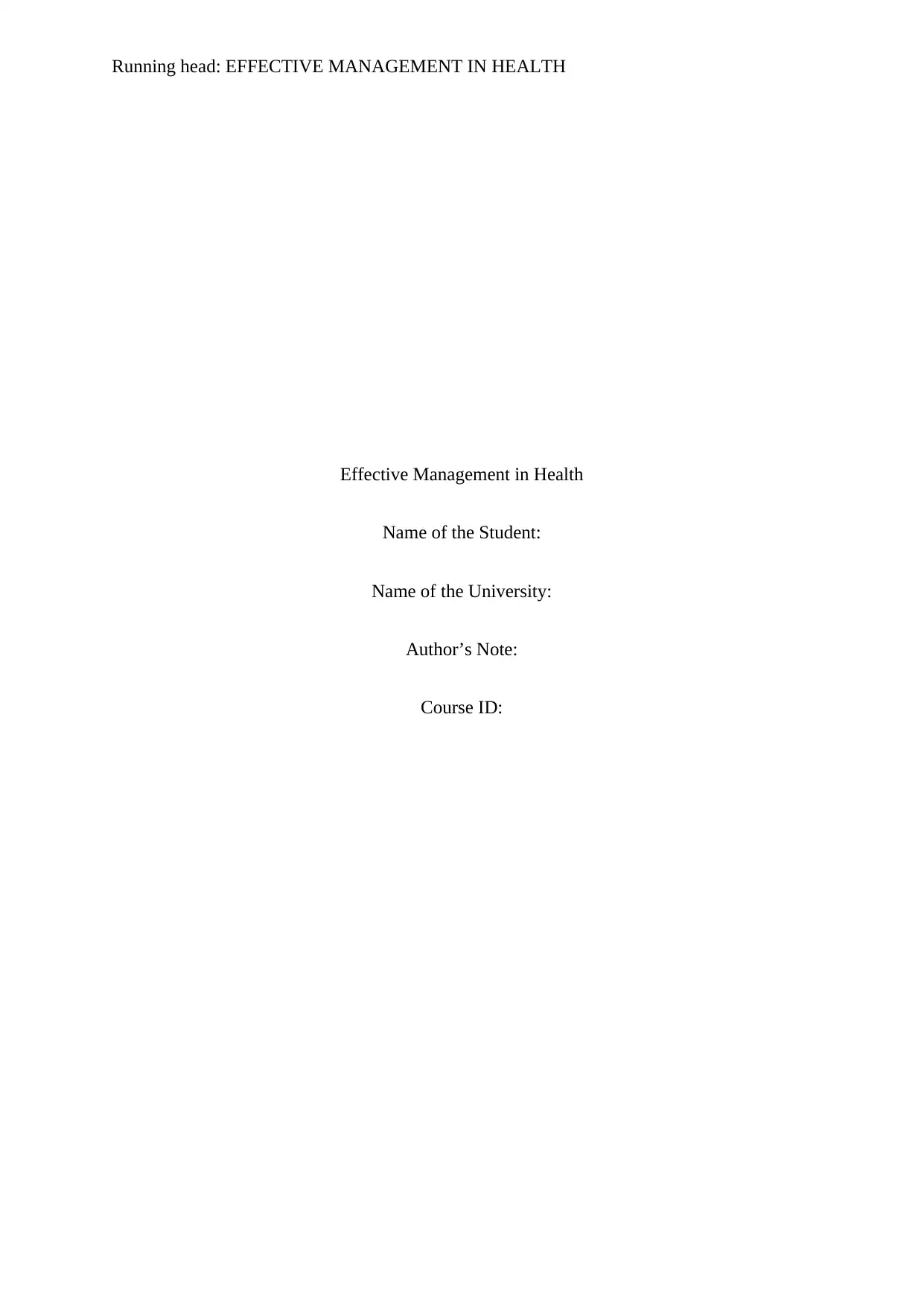
Running head: EFFECTIVE MANAGEMENT IN HEALTH
Effective Management in Health
Name of the Student:
Name of the University:
Author’s Note:
Course ID:
Effective Management in Health
Name of the Student:
Name of the University:
Author’s Note:
Course ID:
Paraphrase This Document
Need a fresh take? Get an instant paraphrase of this document with our AI Paraphraser
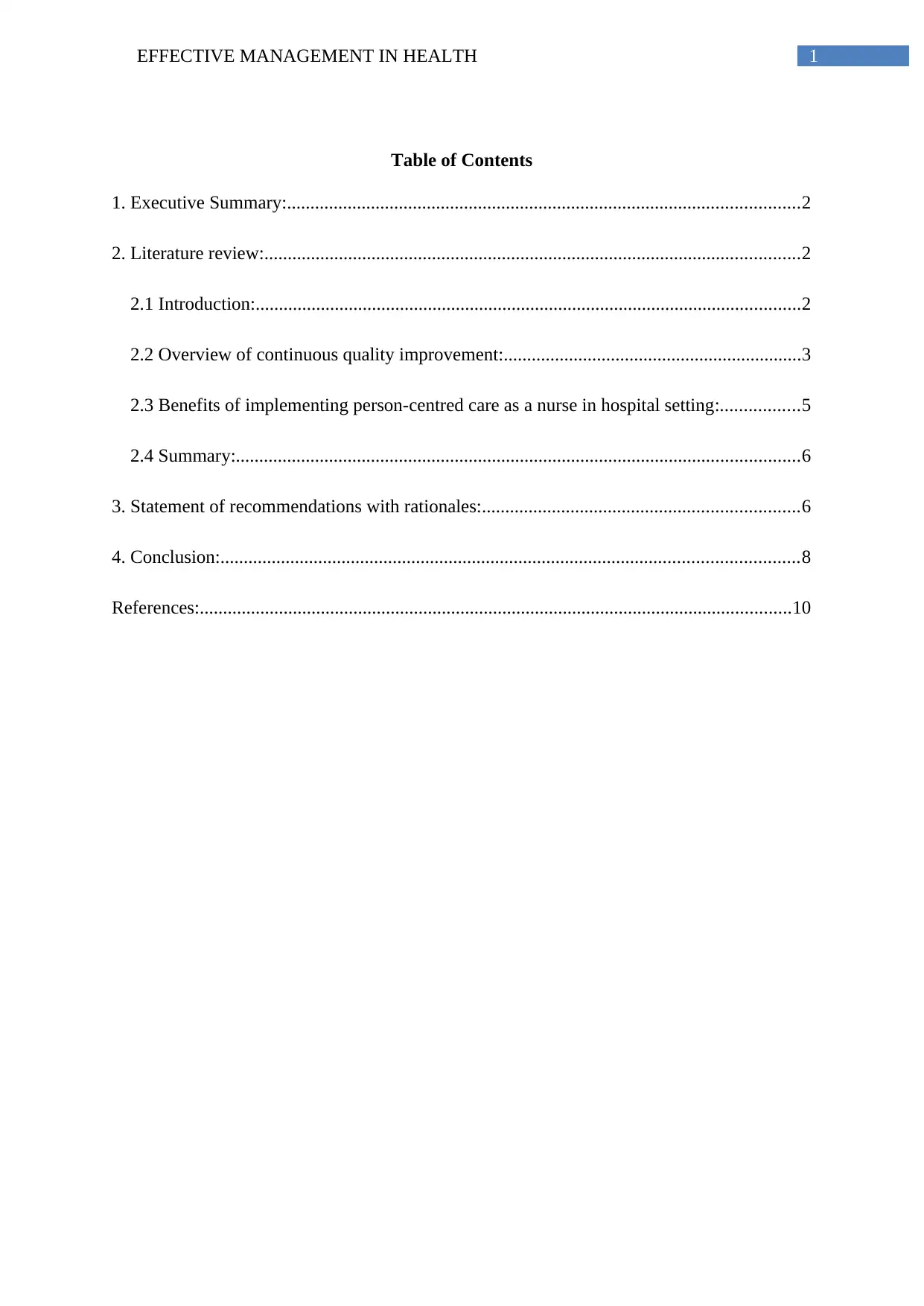
1EFFECTIVE MANAGEMENT IN HEALTH
Table of Contents
1. Executive Summary:..............................................................................................................2
2. Literature review:...................................................................................................................2
2.1 Introduction:.....................................................................................................................2
2.2 Overview of continuous quality improvement:................................................................3
2.3 Benefits of implementing person-centred care as a nurse in hospital setting:.................5
2.4 Summary:.........................................................................................................................6
3. Statement of recommendations with rationales:....................................................................6
4. Conclusion:............................................................................................................................8
References:...............................................................................................................................10
Table of Contents
1. Executive Summary:..............................................................................................................2
2. Literature review:...................................................................................................................2
2.1 Introduction:.....................................................................................................................2
2.2 Overview of continuous quality improvement:................................................................3
2.3 Benefits of implementing person-centred care as a nurse in hospital setting:.................5
2.4 Summary:.........................................................................................................................6
3. Statement of recommendations with rationales:....................................................................6
4. Conclusion:............................................................................................................................8
References:...............................................................................................................................10
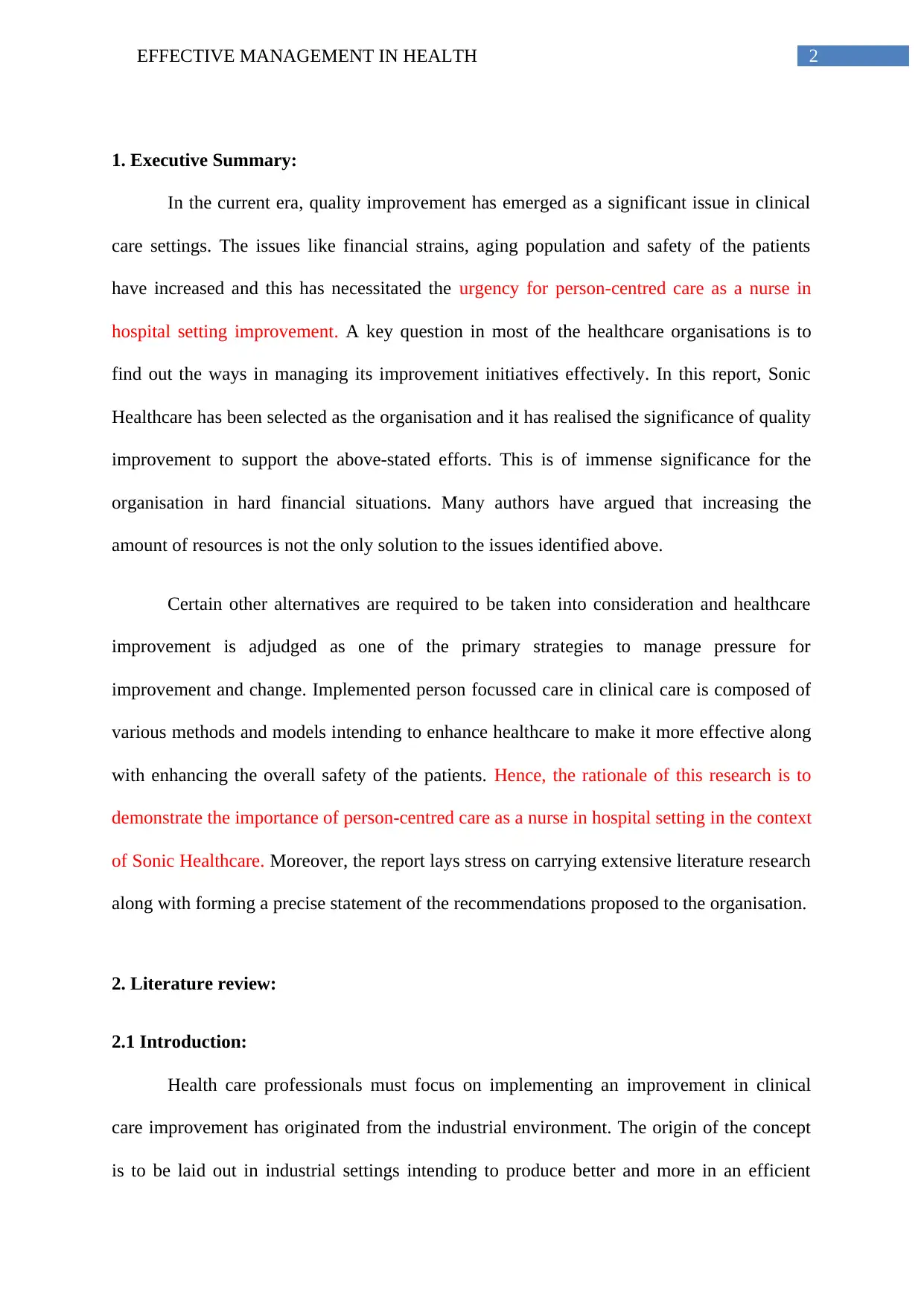
2EFFECTIVE MANAGEMENT IN HEALTH
1. Executive Summary:
In the current era, quality improvement has emerged as a significant issue in clinical
care settings. The issues like financial strains, aging population and safety of the patients
have increased and this has necessitated the urgency for person-centred care as a nurse in
hospital setting improvement. A key question in most of the healthcare organisations is to
find out the ways in managing its improvement initiatives effectively. In this report, Sonic
Healthcare has been selected as the organisation and it has realised the significance of quality
improvement to support the above-stated efforts. This is of immense significance for the
organisation in hard financial situations. Many authors have argued that increasing the
amount of resources is not the only solution to the issues identified above.
Certain other alternatives are required to be taken into consideration and healthcare
improvement is adjudged as one of the primary strategies to manage pressure for
improvement and change. Implemented person focussed care in clinical care is composed of
various methods and models intending to enhance healthcare to make it more effective along
with enhancing the overall safety of the patients. Hence, the rationale of this research is to
demonstrate the importance of person-centred care as a nurse in hospital setting in the context
of Sonic Healthcare. Moreover, the report lays stress on carrying extensive literature research
along with forming a precise statement of the recommendations proposed to the organisation.
2. Literature review:
2.1 Introduction:
Health care professionals must focus on implementing an improvement in clinical
care improvement has originated from the industrial environment. The origin of the concept
is to be laid out in industrial settings intending to produce better and more in an efficient
1. Executive Summary:
In the current era, quality improvement has emerged as a significant issue in clinical
care settings. The issues like financial strains, aging population and safety of the patients
have increased and this has necessitated the urgency for person-centred care as a nurse in
hospital setting improvement. A key question in most of the healthcare organisations is to
find out the ways in managing its improvement initiatives effectively. In this report, Sonic
Healthcare has been selected as the organisation and it has realised the significance of quality
improvement to support the above-stated efforts. This is of immense significance for the
organisation in hard financial situations. Many authors have argued that increasing the
amount of resources is not the only solution to the issues identified above.
Certain other alternatives are required to be taken into consideration and healthcare
improvement is adjudged as one of the primary strategies to manage pressure for
improvement and change. Implemented person focussed care in clinical care is composed of
various methods and models intending to enhance healthcare to make it more effective along
with enhancing the overall safety of the patients. Hence, the rationale of this research is to
demonstrate the importance of person-centred care as a nurse in hospital setting in the context
of Sonic Healthcare. Moreover, the report lays stress on carrying extensive literature research
along with forming a precise statement of the recommendations proposed to the organisation.
2. Literature review:
2.1 Introduction:
Health care professionals must focus on implementing an improvement in clinical
care improvement has originated from the industrial environment. The origin of the concept
is to be laid out in industrial settings intending to produce better and more in an efficient
⊘ This is a preview!⊘
Do you want full access?
Subscribe today to unlock all pages.

Trusted by 1+ million students worldwide
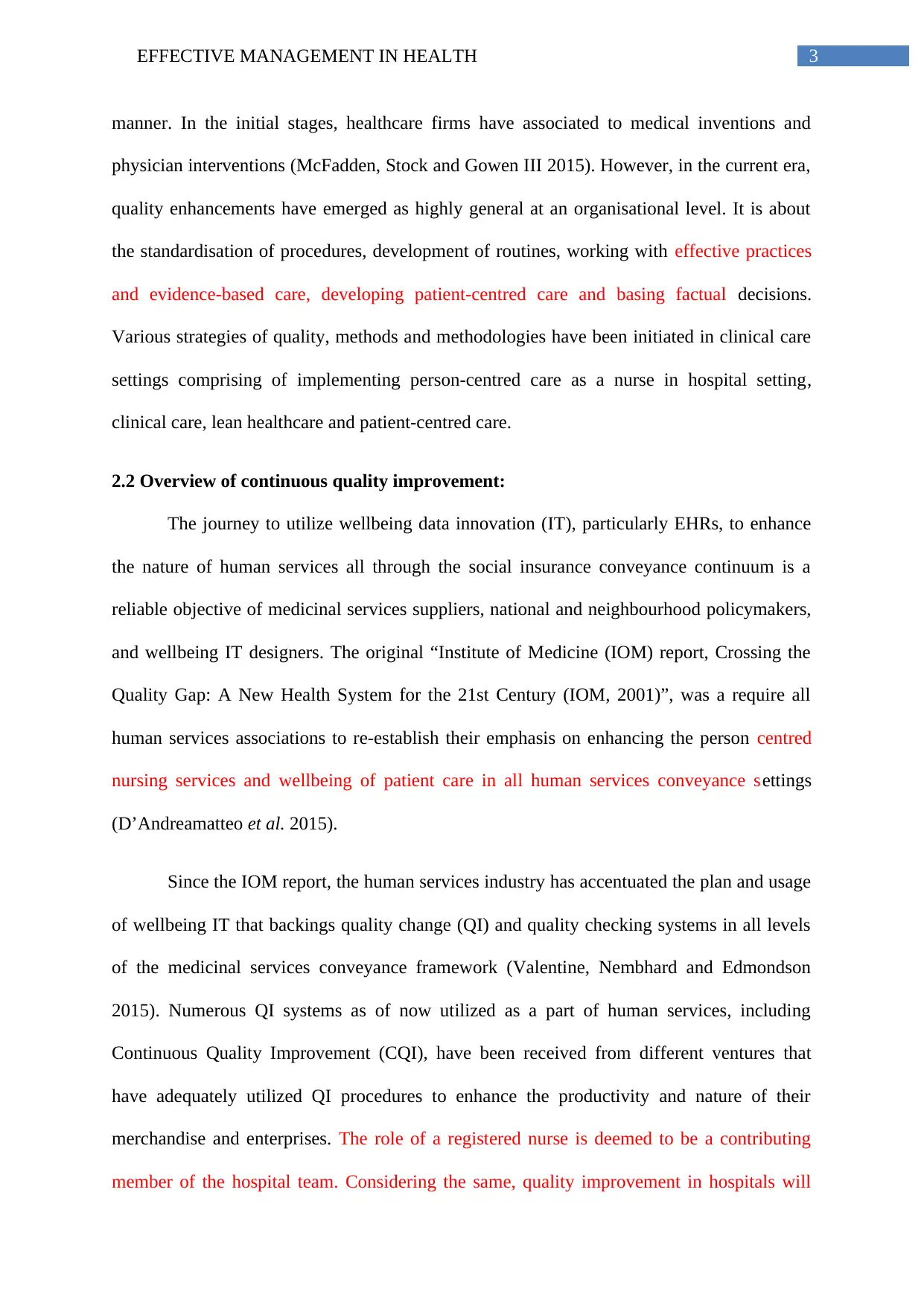
3EFFECTIVE MANAGEMENT IN HEALTH
manner. In the initial stages, healthcare firms have associated to medical inventions and
physician interventions (McFadden, Stock and Gowen III 2015). However, in the current era,
quality enhancements have emerged as highly general at an organisational level. It is about
the standardisation of procedures, development of routines, working with effective practices
and evidence-based care, developing patient-centred care and basing factual decisions.
Various strategies of quality, methods and methodologies have been initiated in clinical care
settings comprising of implementing person-centred care as a nurse in hospital setting,
clinical care, lean healthcare and patient-centred care.
2.2 Overview of continuous quality improvement:
The journey to utilize wellbeing data innovation (IT), particularly EHRs, to enhance
the nature of human services all through the social insurance conveyance continuum is a
reliable objective of medicinal services suppliers, national and neighbourhood policymakers,
and wellbeing IT designers. The original “Institute of Medicine (IOM) report, Crossing the
Quality Gap: A New Health System for the 21st Century (IOM, 2001)”, was a require all
human services associations to re-establish their emphasis on enhancing the person centred
nursing services and wellbeing of patient care in all human services conveyance settings
(D’Andreamatteo et al. 2015).
Since the IOM report, the human services industry has accentuated the plan and usage
of wellbeing IT that backings quality change (QI) and quality checking systems in all levels
of the medicinal services conveyance framework (Valentine, Nembhard and Edmondson
2015). Numerous QI systems as of now utilized as a part of human services, including
Continuous Quality Improvement (CQI), have been received from different ventures that
have adequately utilized QI procedures to enhance the productivity and nature of their
merchandise and enterprises. The role of a registered nurse is deemed to be a contributing
member of the hospital team. Considering the same, quality improvement in hospitals will
manner. In the initial stages, healthcare firms have associated to medical inventions and
physician interventions (McFadden, Stock and Gowen III 2015). However, in the current era,
quality enhancements have emerged as highly general at an organisational level. It is about
the standardisation of procedures, development of routines, working with effective practices
and evidence-based care, developing patient-centred care and basing factual decisions.
Various strategies of quality, methods and methodologies have been initiated in clinical care
settings comprising of implementing person-centred care as a nurse in hospital setting,
clinical care, lean healthcare and patient-centred care.
2.2 Overview of continuous quality improvement:
The journey to utilize wellbeing data innovation (IT), particularly EHRs, to enhance
the nature of human services all through the social insurance conveyance continuum is a
reliable objective of medicinal services suppliers, national and neighbourhood policymakers,
and wellbeing IT designers. The original “Institute of Medicine (IOM) report, Crossing the
Quality Gap: A New Health System for the 21st Century (IOM, 2001)”, was a require all
human services associations to re-establish their emphasis on enhancing the person centred
nursing services and wellbeing of patient care in all human services conveyance settings
(D’Andreamatteo et al. 2015).
Since the IOM report, the human services industry has accentuated the plan and usage
of wellbeing IT that backings quality change (QI) and quality checking systems in all levels
of the medicinal services conveyance framework (Valentine, Nembhard and Edmondson
2015). Numerous QI systems as of now utilized as a part of human services, including
Continuous Quality Improvement (CQI), have been received from different ventures that
have adequately utilized QI procedures to enhance the productivity and nature of their
merchandise and enterprises. The role of a registered nurse is deemed to be a contributing
member of the hospital team. Considering the same, quality improvement in hospitals will
Paraphrase This Document
Need a fresh take? Get an instant paraphrase of this document with our AI Paraphraser
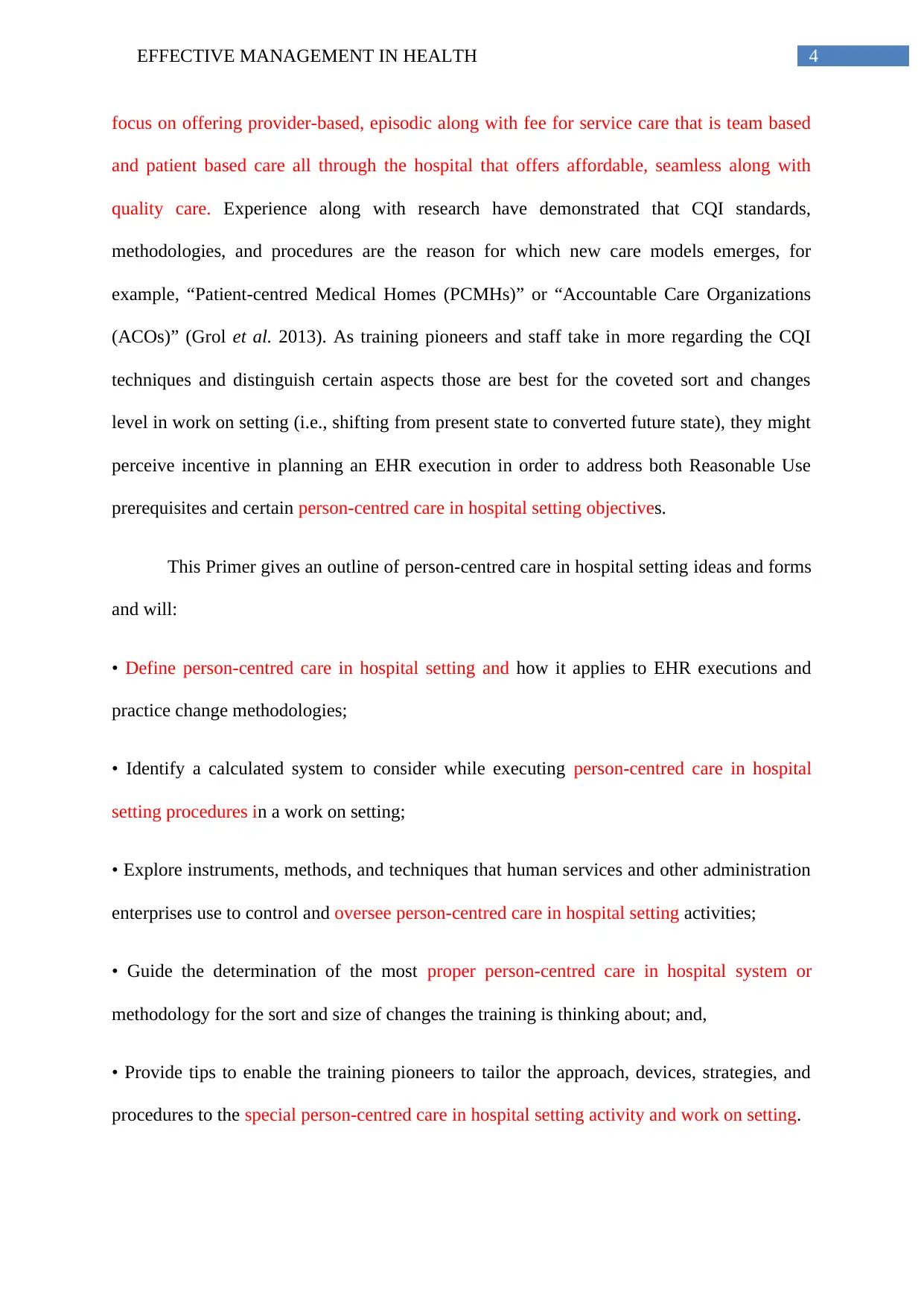
4EFFECTIVE MANAGEMENT IN HEALTH
focus on offering provider-based, episodic along with fee for service care that is team based
and patient based care all through the hospital that offers affordable, seamless along with
quality care. Experience along with research have demonstrated that CQI standards,
methodologies, and procedures are the reason for which new care models emerges, for
example, “Patient-centred Medical Homes (PCMHs)” or “Accountable Care Organizations
(ACOs)” (Grol et al. 2013). As training pioneers and staff take in more regarding the CQI
techniques and distinguish certain aspects those are best for the coveted sort and changes
level in work on setting (i.e., shifting from present state to converted future state), they might
perceive incentive in planning an EHR execution in order to address both Reasonable Use
prerequisites and certain person-centred care in hospital setting objectives.
This Primer gives an outline of person-centred care in hospital setting ideas and forms
and will:
• Define person-centred care in hospital setting and how it applies to EHR executions and
practice change methodologies;
• Identify a calculated system to consider while executing person-centred care in hospital
setting procedures in a work on setting;
• Explore instruments, methods, and techniques that human services and other administration
enterprises use to control and oversee person-centred care in hospital setting activities;
• Guide the determination of the most proper person-centred care in hospital system or
methodology for the sort and size of changes the training is thinking about; and,
• Provide tips to enable the training pioneers to tailor the approach, devices, strategies, and
procedures to the special person-centred care in hospital setting activity and work on setting.
focus on offering provider-based, episodic along with fee for service care that is team based
and patient based care all through the hospital that offers affordable, seamless along with
quality care. Experience along with research have demonstrated that CQI standards,
methodologies, and procedures are the reason for which new care models emerges, for
example, “Patient-centred Medical Homes (PCMHs)” or “Accountable Care Organizations
(ACOs)” (Grol et al. 2013). As training pioneers and staff take in more regarding the CQI
techniques and distinguish certain aspects those are best for the coveted sort and changes
level in work on setting (i.e., shifting from present state to converted future state), they might
perceive incentive in planning an EHR execution in order to address both Reasonable Use
prerequisites and certain person-centred care in hospital setting objectives.
This Primer gives an outline of person-centred care in hospital setting ideas and forms
and will:
• Define person-centred care in hospital setting and how it applies to EHR executions and
practice change methodologies;
• Identify a calculated system to consider while executing person-centred care in hospital
setting procedures in a work on setting;
• Explore instruments, methods, and techniques that human services and other administration
enterprises use to control and oversee person-centred care in hospital setting activities;
• Guide the determination of the most proper person-centred care in hospital system or
methodology for the sort and size of changes the training is thinking about; and,
• Provide tips to enable the training pioneers to tailor the approach, devices, strategies, and
procedures to the special person-centred care in hospital setting activity and work on setting.
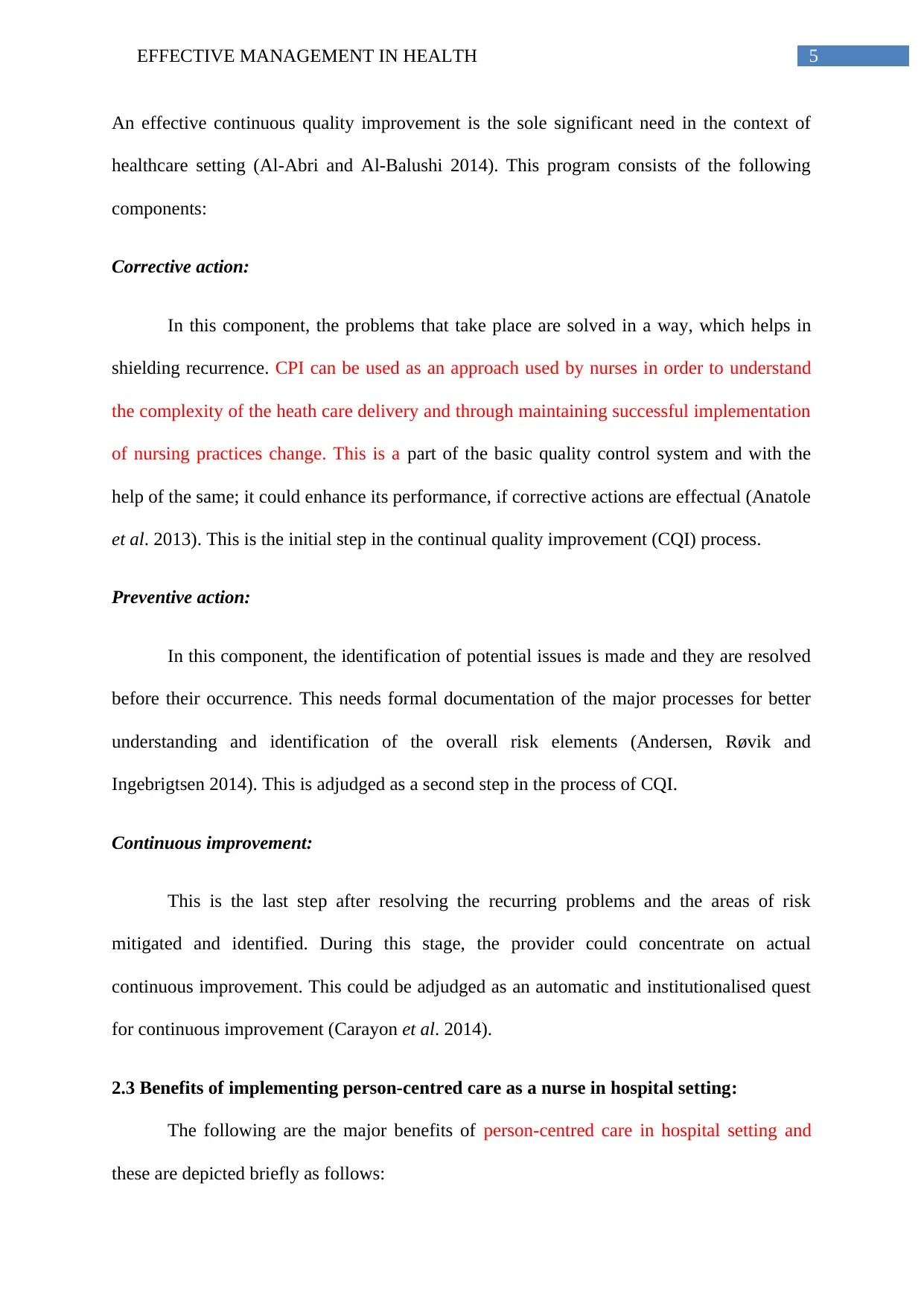
5EFFECTIVE MANAGEMENT IN HEALTH
An effective continuous quality improvement is the sole significant need in the context of
healthcare setting (Al-Abri and Al-Balushi 2014). This program consists of the following
components:
Corrective action:
In this component, the problems that take place are solved in a way, which helps in
shielding recurrence. CPI can be used as an approach used by nurses in order to understand
the complexity of the heath care delivery and through maintaining successful implementation
of nursing practices change. This is a part of the basic quality control system and with the
help of the same; it could enhance its performance, if corrective actions are effectual (Anatole
et al. 2013). This is the initial step in the continual quality improvement (CQI) process.
Preventive action:
In this component, the identification of potential issues is made and they are resolved
before their occurrence. This needs formal documentation of the major processes for better
understanding and identification of the overall risk elements (Andersen, Røvik and
Ingebrigtsen 2014). This is adjudged as a second step in the process of CQI.
Continuous improvement:
This is the last step after resolving the recurring problems and the areas of risk
mitigated and identified. During this stage, the provider could concentrate on actual
continuous improvement. This could be adjudged as an automatic and institutionalised quest
for continuous improvement (Carayon et al. 2014).
2.3 Benefits of implementing person-centred care as a nurse in hospital setting:
The following are the major benefits of person-centred care in hospital setting and
these are depicted briefly as follows:
An effective continuous quality improvement is the sole significant need in the context of
healthcare setting (Al-Abri and Al-Balushi 2014). This program consists of the following
components:
Corrective action:
In this component, the problems that take place are solved in a way, which helps in
shielding recurrence. CPI can be used as an approach used by nurses in order to understand
the complexity of the heath care delivery and through maintaining successful implementation
of nursing practices change. This is a part of the basic quality control system and with the
help of the same; it could enhance its performance, if corrective actions are effectual (Anatole
et al. 2013). This is the initial step in the continual quality improvement (CQI) process.
Preventive action:
In this component, the identification of potential issues is made and they are resolved
before their occurrence. This needs formal documentation of the major processes for better
understanding and identification of the overall risk elements (Andersen, Røvik and
Ingebrigtsen 2014). This is adjudged as a second step in the process of CQI.
Continuous improvement:
This is the last step after resolving the recurring problems and the areas of risk
mitigated and identified. During this stage, the provider could concentrate on actual
continuous improvement. This could be adjudged as an automatic and institutionalised quest
for continuous improvement (Carayon et al. 2014).
2.3 Benefits of implementing person-centred care as a nurse in hospital setting:
The following are the major benefits of person-centred care in hospital setting and
these are depicted briefly as follows:
⊘ This is a preview!⊘
Do you want full access?
Subscribe today to unlock all pages.

Trusted by 1+ million students worldwide
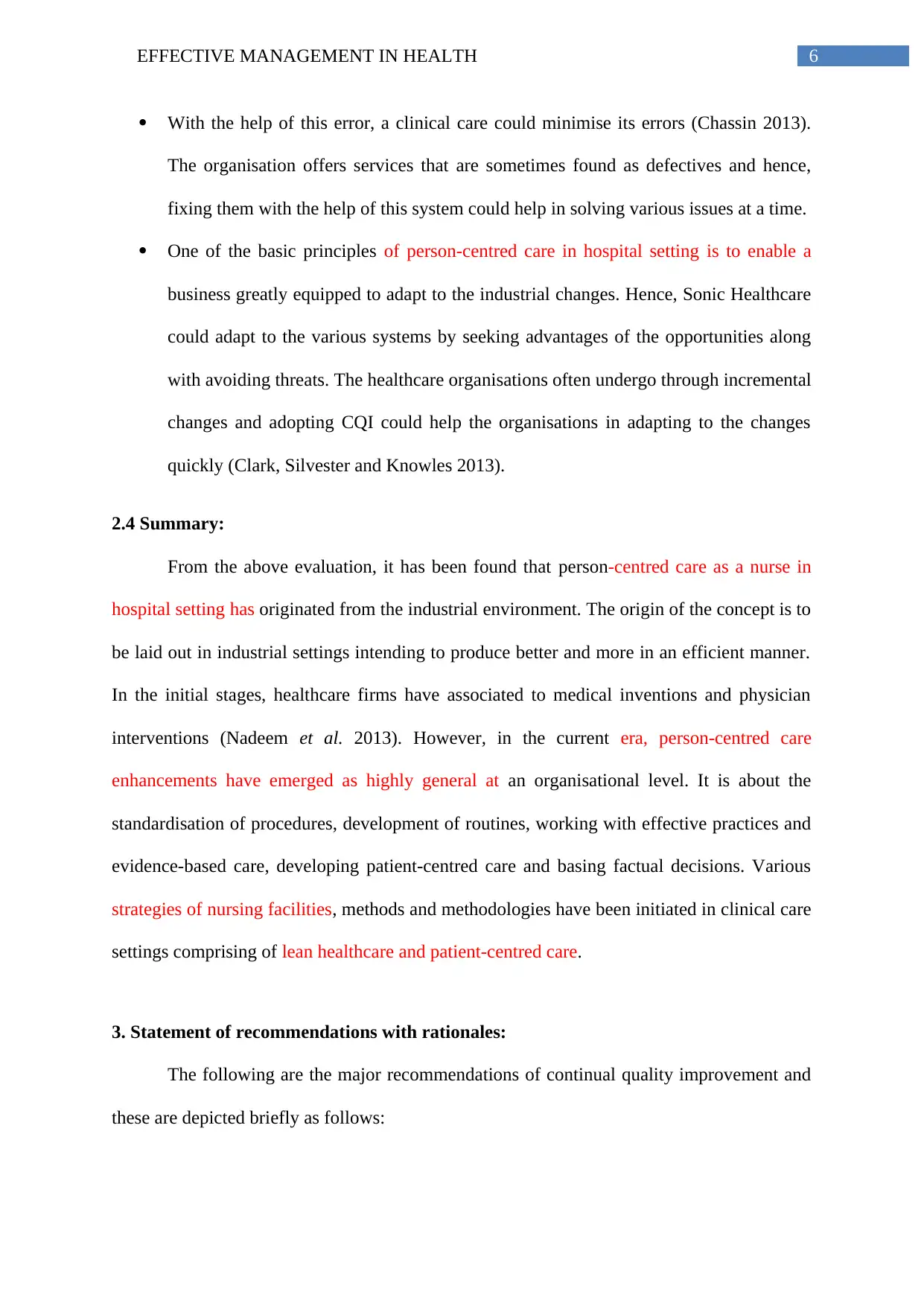
6EFFECTIVE MANAGEMENT IN HEALTH
With the help of this error, a clinical care could minimise its errors (Chassin 2013).
The organisation offers services that are sometimes found as defectives and hence,
fixing them with the help of this system could help in solving various issues at a time.
One of the basic principles of person-centred care in hospital setting is to enable a
business greatly equipped to adapt to the industrial changes. Hence, Sonic Healthcare
could adapt to the various systems by seeking advantages of the opportunities along
with avoiding threats. The healthcare organisations often undergo through incremental
changes and adopting CQI could help the organisations in adapting to the changes
quickly (Clark, Silvester and Knowles 2013).
2.4 Summary:
From the above evaluation, it has been found that person-centred care as a nurse in
hospital setting has originated from the industrial environment. The origin of the concept is to
be laid out in industrial settings intending to produce better and more in an efficient manner.
In the initial stages, healthcare firms have associated to medical inventions and physician
interventions (Nadeem et al. 2013). However, in the current era, person-centred care
enhancements have emerged as highly general at an organisational level. It is about the
standardisation of procedures, development of routines, working with effective practices and
evidence-based care, developing patient-centred care and basing factual decisions. Various
strategies of nursing facilities, methods and methodologies have been initiated in clinical care
settings comprising of lean healthcare and patient-centred care.
3. Statement of recommendations with rationales:
The following are the major recommendations of continual quality improvement and
these are depicted briefly as follows:
With the help of this error, a clinical care could minimise its errors (Chassin 2013).
The organisation offers services that are sometimes found as defectives and hence,
fixing them with the help of this system could help in solving various issues at a time.
One of the basic principles of person-centred care in hospital setting is to enable a
business greatly equipped to adapt to the industrial changes. Hence, Sonic Healthcare
could adapt to the various systems by seeking advantages of the opportunities along
with avoiding threats. The healthcare organisations often undergo through incremental
changes and adopting CQI could help the organisations in adapting to the changes
quickly (Clark, Silvester and Knowles 2013).
2.4 Summary:
From the above evaluation, it has been found that person-centred care as a nurse in
hospital setting has originated from the industrial environment. The origin of the concept is to
be laid out in industrial settings intending to produce better and more in an efficient manner.
In the initial stages, healthcare firms have associated to medical inventions and physician
interventions (Nadeem et al. 2013). However, in the current era, person-centred care
enhancements have emerged as highly general at an organisational level. It is about the
standardisation of procedures, development of routines, working with effective practices and
evidence-based care, developing patient-centred care and basing factual decisions. Various
strategies of nursing facilities, methods and methodologies have been initiated in clinical care
settings comprising of lean healthcare and patient-centred care.
3. Statement of recommendations with rationales:
The following are the major recommendations of continual quality improvement and
these are depicted briefly as follows:
Paraphrase This Document
Need a fresh take? Get an instant paraphrase of this document with our AI Paraphraser
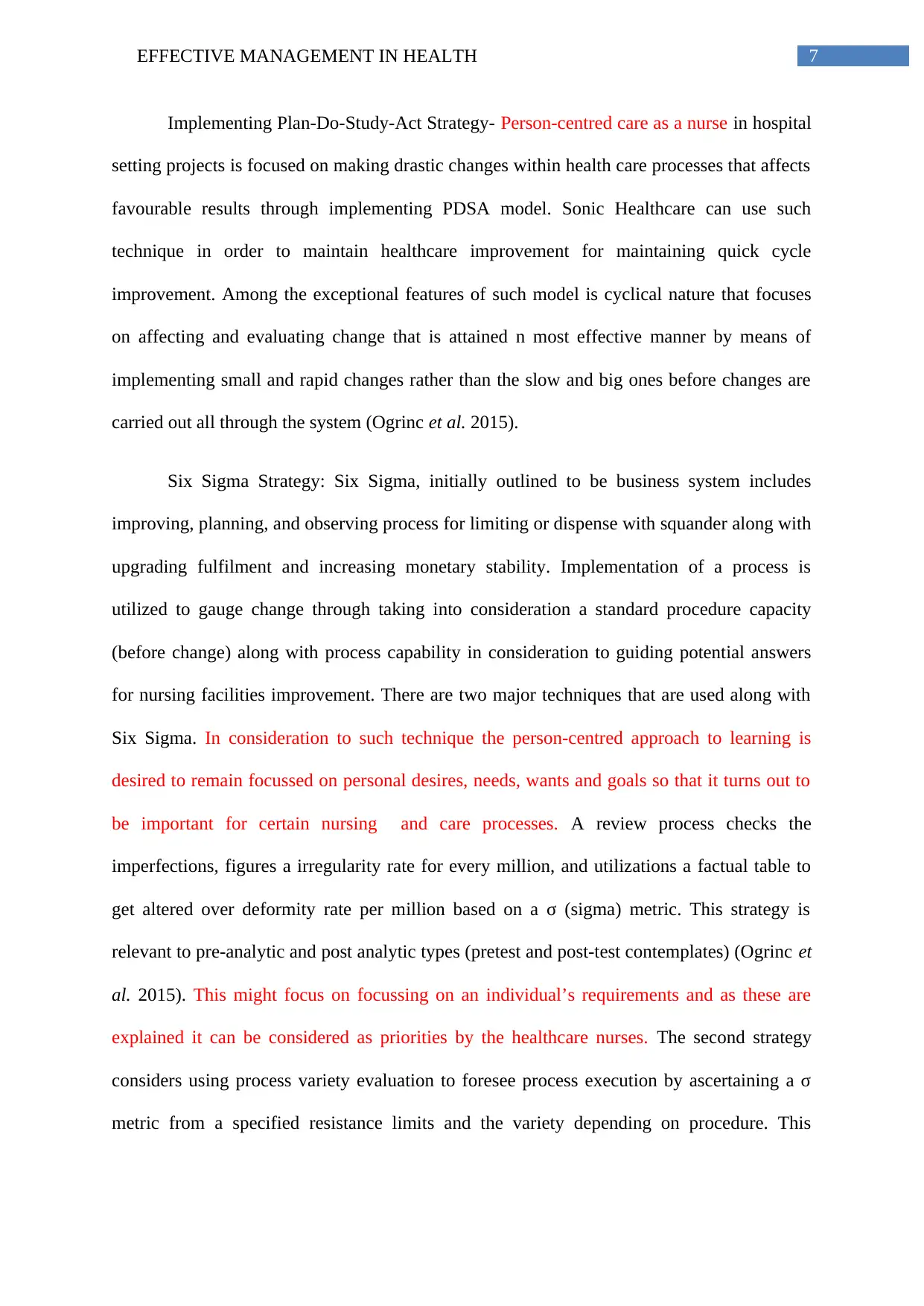
7EFFECTIVE MANAGEMENT IN HEALTH
Implementing Plan-Do-Study-Act Strategy- Person-centred care as a nurse in hospital
setting projects is focused on making drastic changes within health care processes that affects
favourable results through implementing PDSA model. Sonic Healthcare can use such
technique in order to maintain healthcare improvement for maintaining quick cycle
improvement. Among the exceptional features of such model is cyclical nature that focuses
on affecting and evaluating change that is attained n most effective manner by means of
implementing small and rapid changes rather than the slow and big ones before changes are
carried out all through the system (Ogrinc et al. 2015).
Six Sigma Strategy: Six Sigma, initially outlined to be business system includes
improving, planning, and observing process for limiting or dispense with squander along with
upgrading fulfilment and increasing monetary stability. Implementation of a process is
utilized to gauge change through taking into consideration a standard procedure capacity
(before change) along with process capability in consideration to guiding potential answers
for nursing facilities improvement. There are two major techniques that are used along with
Six Sigma. In consideration to such technique the person-centred approach to learning is
desired to remain focussed on personal desires, needs, wants and goals so that it turns out to
be important for certain nursing and care processes. A review process checks the
imperfections, figures a irregularity rate for every million, and utilizations a factual table to
get altered over deformity rate per million based on a σ (sigma) metric. This strategy is
relevant to pre-analytic and post analytic types (pretest and post-test contemplates) (Ogrinc et
al. 2015). This might focus on focussing on an individual’s requirements and as these are
explained it can be considered as priorities by the healthcare nurses. The second strategy
considers using process variety evaluation to foresee process execution by ascertaining a σ
metric from a specified resistance limits and the variety depending on procedure. This
Implementing Plan-Do-Study-Act Strategy- Person-centred care as a nurse in hospital
setting projects is focused on making drastic changes within health care processes that affects
favourable results through implementing PDSA model. Sonic Healthcare can use such
technique in order to maintain healthcare improvement for maintaining quick cycle
improvement. Among the exceptional features of such model is cyclical nature that focuses
on affecting and evaluating change that is attained n most effective manner by means of
implementing small and rapid changes rather than the slow and big ones before changes are
carried out all through the system (Ogrinc et al. 2015).
Six Sigma Strategy: Six Sigma, initially outlined to be business system includes
improving, planning, and observing process for limiting or dispense with squander along with
upgrading fulfilment and increasing monetary stability. Implementation of a process is
utilized to gauge change through taking into consideration a standard procedure capacity
(before change) along with process capability in consideration to guiding potential answers
for nursing facilities improvement. There are two major techniques that are used along with
Six Sigma. In consideration to such technique the person-centred approach to learning is
desired to remain focussed on personal desires, needs, wants and goals so that it turns out to
be important for certain nursing and care processes. A review process checks the
imperfections, figures a irregularity rate for every million, and utilizations a factual table to
get altered over deformity rate per million based on a σ (sigma) metric. This strategy is
relevant to pre-analytic and post analytic types (pretest and post-test contemplates) (Ogrinc et
al. 2015). This might focus on focussing on an individual’s requirements and as these are
explained it can be considered as priorities by the healthcare nurses. The second strategy
considers using process variety evaluation to foresee process execution by ascertaining a σ
metric from a specified resistance limits and the variety depending on procedure. This
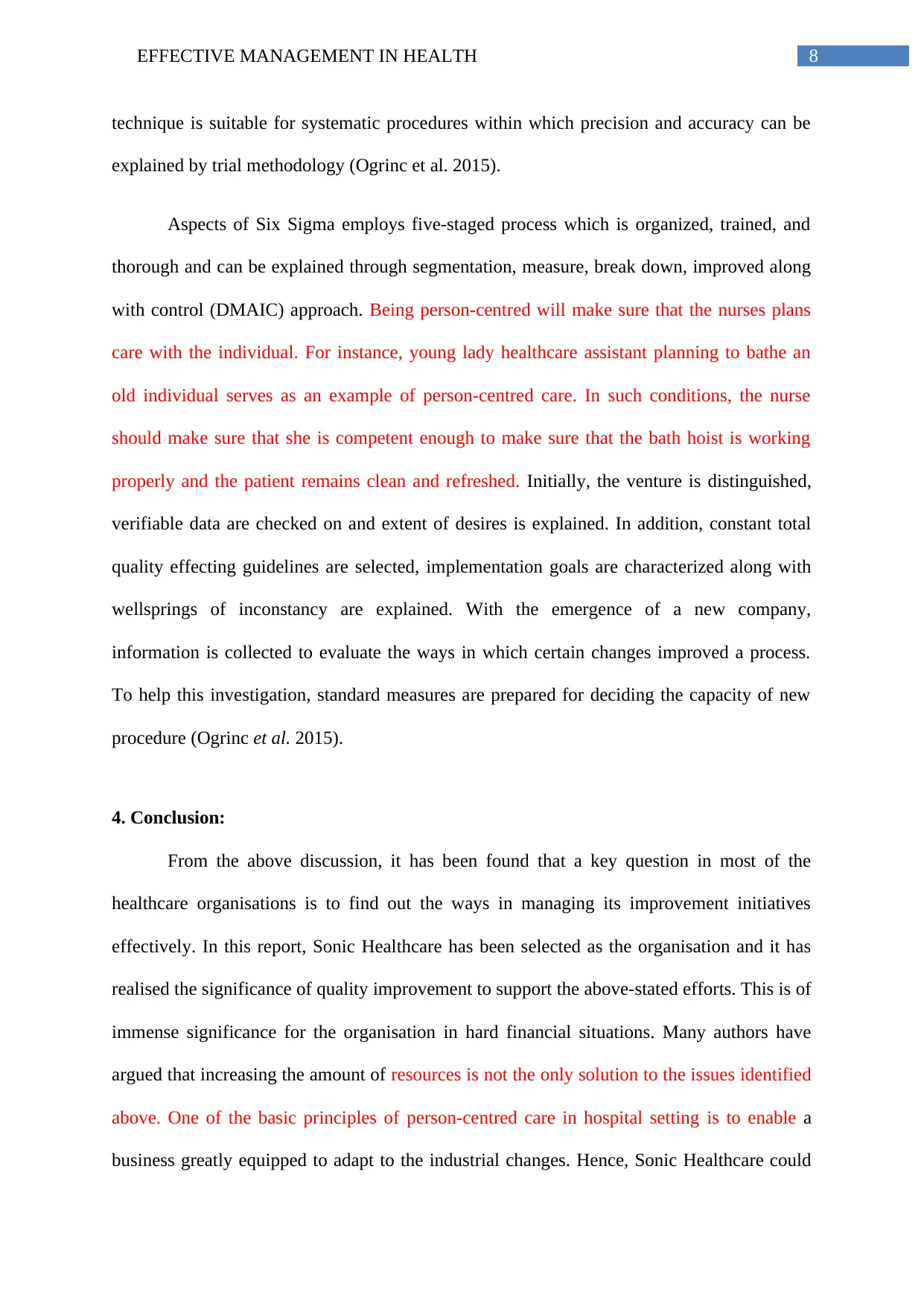
8EFFECTIVE MANAGEMENT IN HEALTH
technique is suitable for systematic procedures within which precision and accuracy can be
explained by trial methodology (Ogrinc et al. 2015).
Aspects of Six Sigma employs five-staged process which is organized, trained, and
thorough and can be explained through segmentation, measure, break down, improved along
with control (DMAIC) approach. Being person-centred will make sure that the nurses plans
care with the individual. For instance, young lady healthcare assistant planning to bathe an
old individual serves as an example of person-centred care. In such conditions, the nurse
should make sure that she is competent enough to make sure that the bath hoist is working
properly and the patient remains clean and refreshed. Initially, the venture is distinguished,
verifiable data are checked on and extent of desires is explained. In addition, constant total
quality effecting guidelines are selected, implementation goals are characterized along with
wellsprings of inconstancy are explained. With the emergence of a new company,
information is collected to evaluate the ways in which certain changes improved a process.
To help this investigation, standard measures are prepared for deciding the capacity of new
procedure (Ogrinc et al. 2015).
4. Conclusion:
From the above discussion, it has been found that a key question in most of the
healthcare organisations is to find out the ways in managing its improvement initiatives
effectively. In this report, Sonic Healthcare has been selected as the organisation and it has
realised the significance of quality improvement to support the above-stated efforts. This is of
immense significance for the organisation in hard financial situations. Many authors have
argued that increasing the amount of resources is not the only solution to the issues identified
above. One of the basic principles of person-centred care in hospital setting is to enable a
business greatly equipped to adapt to the industrial changes. Hence, Sonic Healthcare could
technique is suitable for systematic procedures within which precision and accuracy can be
explained by trial methodology (Ogrinc et al. 2015).
Aspects of Six Sigma employs five-staged process which is organized, trained, and
thorough and can be explained through segmentation, measure, break down, improved along
with control (DMAIC) approach. Being person-centred will make sure that the nurses plans
care with the individual. For instance, young lady healthcare assistant planning to bathe an
old individual serves as an example of person-centred care. In such conditions, the nurse
should make sure that she is competent enough to make sure that the bath hoist is working
properly and the patient remains clean and refreshed. Initially, the venture is distinguished,
verifiable data are checked on and extent of desires is explained. In addition, constant total
quality effecting guidelines are selected, implementation goals are characterized along with
wellsprings of inconstancy are explained. With the emergence of a new company,
information is collected to evaluate the ways in which certain changes improved a process.
To help this investigation, standard measures are prepared for deciding the capacity of new
procedure (Ogrinc et al. 2015).
4. Conclusion:
From the above discussion, it has been found that a key question in most of the
healthcare organisations is to find out the ways in managing its improvement initiatives
effectively. In this report, Sonic Healthcare has been selected as the organisation and it has
realised the significance of quality improvement to support the above-stated efforts. This is of
immense significance for the organisation in hard financial situations. Many authors have
argued that increasing the amount of resources is not the only solution to the issues identified
above. One of the basic principles of person-centred care in hospital setting is to enable a
business greatly equipped to adapt to the industrial changes. Hence, Sonic Healthcare could
⊘ This is a preview!⊘
Do you want full access?
Subscribe today to unlock all pages.

Trusted by 1+ million students worldwide
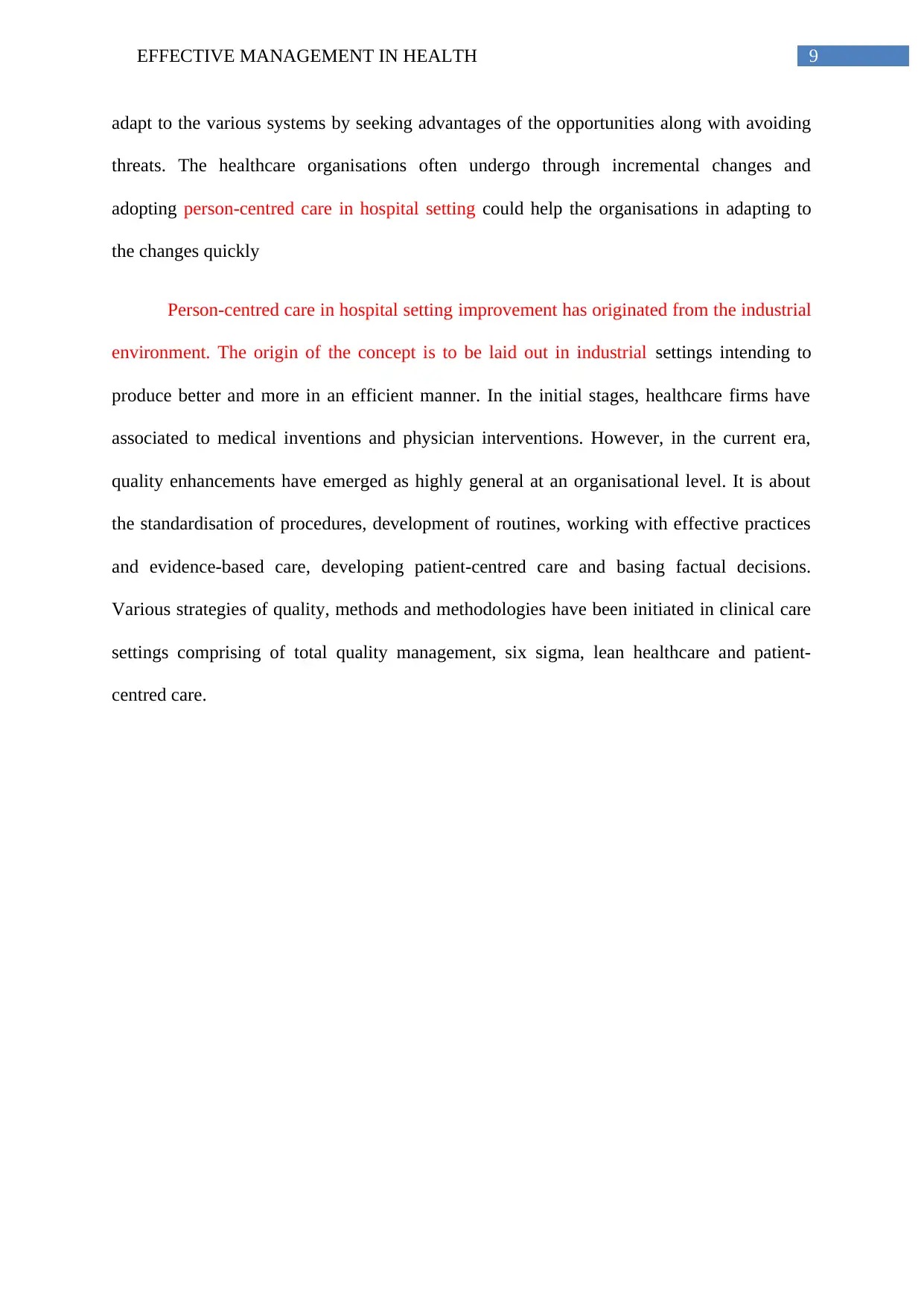
9EFFECTIVE MANAGEMENT IN HEALTH
adapt to the various systems by seeking advantages of the opportunities along with avoiding
threats. The healthcare organisations often undergo through incremental changes and
adopting person-centred care in hospital setting could help the organisations in adapting to
the changes quickly
Person-centred care in hospital setting improvement has originated from the industrial
environment. The origin of the concept is to be laid out in industrial settings intending to
produce better and more in an efficient manner. In the initial stages, healthcare firms have
associated to medical inventions and physician interventions. However, in the current era,
quality enhancements have emerged as highly general at an organisational level. It is about
the standardisation of procedures, development of routines, working with effective practices
and evidence-based care, developing patient-centred care and basing factual decisions.
Various strategies of quality, methods and methodologies have been initiated in clinical care
settings comprising of total quality management, six sigma, lean healthcare and patient-
centred care.
adapt to the various systems by seeking advantages of the opportunities along with avoiding
threats. The healthcare organisations often undergo through incremental changes and
adopting person-centred care in hospital setting could help the organisations in adapting to
the changes quickly
Person-centred care in hospital setting improvement has originated from the industrial
environment. The origin of the concept is to be laid out in industrial settings intending to
produce better and more in an efficient manner. In the initial stages, healthcare firms have
associated to medical inventions and physician interventions. However, in the current era,
quality enhancements have emerged as highly general at an organisational level. It is about
the standardisation of procedures, development of routines, working with effective practices
and evidence-based care, developing patient-centred care and basing factual decisions.
Various strategies of quality, methods and methodologies have been initiated in clinical care
settings comprising of total quality management, six sigma, lean healthcare and patient-
centred care.
Paraphrase This Document
Need a fresh take? Get an instant paraphrase of this document with our AI Paraphraser
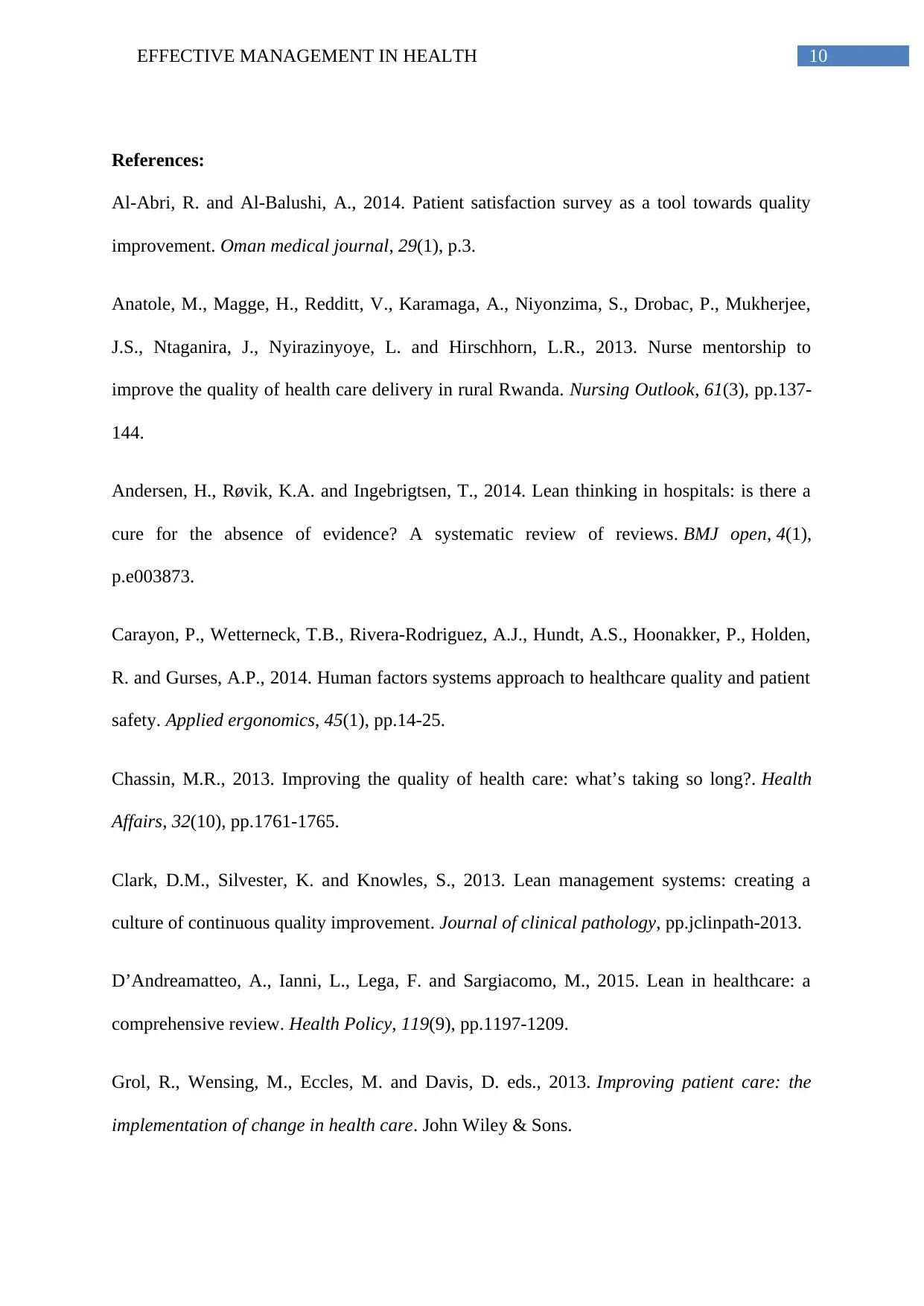
10EFFECTIVE MANAGEMENT IN HEALTH
References:
Al-Abri, R. and Al-Balushi, A., 2014. Patient satisfaction survey as a tool towards quality
improvement. Oman medical journal, 29(1), p.3.
Anatole, M., Magge, H., Redditt, V., Karamaga, A., Niyonzima, S., Drobac, P., Mukherjee,
J.S., Ntaganira, J., Nyirazinyoye, L. and Hirschhorn, L.R., 2013. Nurse mentorship to
improve the quality of health care delivery in rural Rwanda. Nursing Outlook, 61(3), pp.137-
144.
Andersen, H., Røvik, K.A. and Ingebrigtsen, T., 2014. Lean thinking in hospitals: is there a
cure for the absence of evidence? A systematic review of reviews. BMJ open, 4(1),
p.e003873.
Carayon, P., Wetterneck, T.B., Rivera-Rodriguez, A.J., Hundt, A.S., Hoonakker, P., Holden,
R. and Gurses, A.P., 2014. Human factors systems approach to healthcare quality and patient
safety. Applied ergonomics, 45(1), pp.14-25.
Chassin, M.R., 2013. Improving the quality of health care: what’s taking so long?. Health
Affairs, 32(10), pp.1761-1765.
Clark, D.M., Silvester, K. and Knowles, S., 2013. Lean management systems: creating a
culture of continuous quality improvement. Journal of clinical pathology, pp.jclinpath-2013.
D’Andreamatteo, A., Ianni, L., Lega, F. and Sargiacomo, M., 2015. Lean in healthcare: a
comprehensive review. Health Policy, 119(9), pp.1197-1209.
Grol, R., Wensing, M., Eccles, M. and Davis, D. eds., 2013. Improving patient care: the
implementation of change in health care. John Wiley & Sons.
References:
Al-Abri, R. and Al-Balushi, A., 2014. Patient satisfaction survey as a tool towards quality
improvement. Oman medical journal, 29(1), p.3.
Anatole, M., Magge, H., Redditt, V., Karamaga, A., Niyonzima, S., Drobac, P., Mukherjee,
J.S., Ntaganira, J., Nyirazinyoye, L. and Hirschhorn, L.R., 2013. Nurse mentorship to
improve the quality of health care delivery in rural Rwanda. Nursing Outlook, 61(3), pp.137-
144.
Andersen, H., Røvik, K.A. and Ingebrigtsen, T., 2014. Lean thinking in hospitals: is there a
cure for the absence of evidence? A systematic review of reviews. BMJ open, 4(1),
p.e003873.
Carayon, P., Wetterneck, T.B., Rivera-Rodriguez, A.J., Hundt, A.S., Hoonakker, P., Holden,
R. and Gurses, A.P., 2014. Human factors systems approach to healthcare quality and patient
safety. Applied ergonomics, 45(1), pp.14-25.
Chassin, M.R., 2013. Improving the quality of health care: what’s taking so long?. Health
Affairs, 32(10), pp.1761-1765.
Clark, D.M., Silvester, K. and Knowles, S., 2013. Lean management systems: creating a
culture of continuous quality improvement. Journal of clinical pathology, pp.jclinpath-2013.
D’Andreamatteo, A., Ianni, L., Lega, F. and Sargiacomo, M., 2015. Lean in healthcare: a
comprehensive review. Health Policy, 119(9), pp.1197-1209.
Grol, R., Wensing, M., Eccles, M. and Davis, D. eds., 2013. Improving patient care: the
implementation of change in health care. John Wiley & Sons.
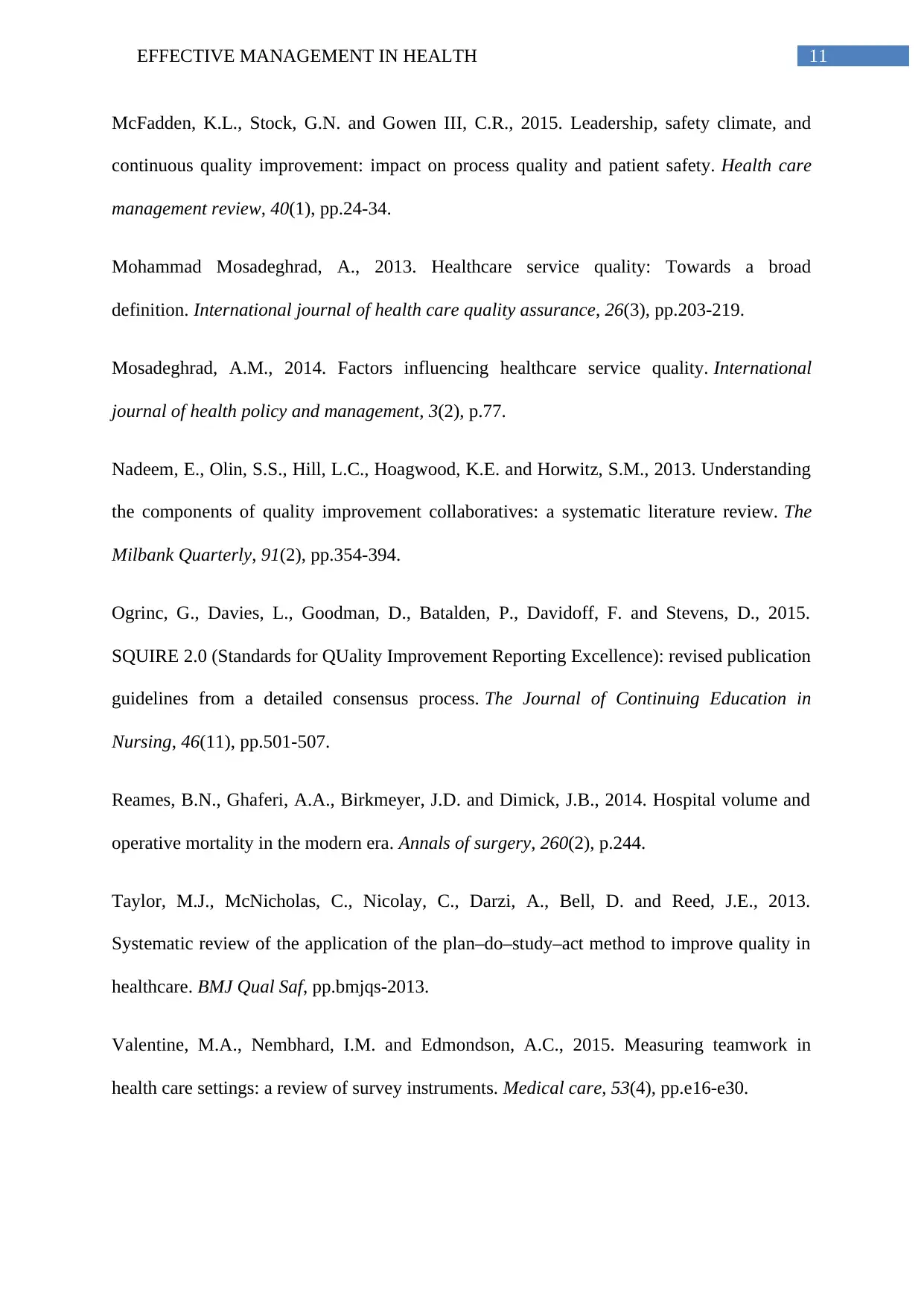
11EFFECTIVE MANAGEMENT IN HEALTH
McFadden, K.L., Stock, G.N. and Gowen III, C.R., 2015. Leadership, safety climate, and
continuous quality improvement: impact on process quality and patient safety. Health care
management review, 40(1), pp.24-34.
Mohammad Mosadeghrad, A., 2013. Healthcare service quality: Towards a broad
definition. International journal of health care quality assurance, 26(3), pp.203-219.
Mosadeghrad, A.M., 2014. Factors influencing healthcare service quality. International
journal of health policy and management, 3(2), p.77.
Nadeem, E., Olin, S.S., Hill, L.C., Hoagwood, K.E. and Horwitz, S.M., 2013. Understanding
the components of quality improvement collaboratives: a systematic literature review. The
Milbank Quarterly, 91(2), pp.354-394.
Ogrinc, G., Davies, L., Goodman, D., Batalden, P., Davidoff, F. and Stevens, D., 2015.
SQUIRE 2.0 (Standards for QUality Improvement Reporting Excellence): revised publication
guidelines from a detailed consensus process. The Journal of Continuing Education in
Nursing, 46(11), pp.501-507.
Reames, B.N., Ghaferi, A.A., Birkmeyer, J.D. and Dimick, J.B., 2014. Hospital volume and
operative mortality in the modern era. Annals of surgery, 260(2), p.244.
Taylor, M.J., McNicholas, C., Nicolay, C., Darzi, A., Bell, D. and Reed, J.E., 2013.
Systematic review of the application of the plan–do–study–act method to improve quality in
healthcare. BMJ Qual Saf, pp.bmjqs-2013.
Valentine, M.A., Nembhard, I.M. and Edmondson, A.C., 2015. Measuring teamwork in
health care settings: a review of survey instruments. Medical care, 53(4), pp.e16-e30.
McFadden, K.L., Stock, G.N. and Gowen III, C.R., 2015. Leadership, safety climate, and
continuous quality improvement: impact on process quality and patient safety. Health care
management review, 40(1), pp.24-34.
Mohammad Mosadeghrad, A., 2013. Healthcare service quality: Towards a broad
definition. International journal of health care quality assurance, 26(3), pp.203-219.
Mosadeghrad, A.M., 2014. Factors influencing healthcare service quality. International
journal of health policy and management, 3(2), p.77.
Nadeem, E., Olin, S.S., Hill, L.C., Hoagwood, K.E. and Horwitz, S.M., 2013. Understanding
the components of quality improvement collaboratives: a systematic literature review. The
Milbank Quarterly, 91(2), pp.354-394.
Ogrinc, G., Davies, L., Goodman, D., Batalden, P., Davidoff, F. and Stevens, D., 2015.
SQUIRE 2.0 (Standards for QUality Improvement Reporting Excellence): revised publication
guidelines from a detailed consensus process. The Journal of Continuing Education in
Nursing, 46(11), pp.501-507.
Reames, B.N., Ghaferi, A.A., Birkmeyer, J.D. and Dimick, J.B., 2014. Hospital volume and
operative mortality in the modern era. Annals of surgery, 260(2), p.244.
Taylor, M.J., McNicholas, C., Nicolay, C., Darzi, A., Bell, D. and Reed, J.E., 2013.
Systematic review of the application of the plan–do–study–act method to improve quality in
healthcare. BMJ Qual Saf, pp.bmjqs-2013.
Valentine, M.A., Nembhard, I.M. and Edmondson, A.C., 2015. Measuring teamwork in
health care settings: a review of survey instruments. Medical care, 53(4), pp.e16-e30.
⊘ This is a preview!⊘
Do you want full access?
Subscribe today to unlock all pages.

Trusted by 1+ million students worldwide
1 out of 12
Related Documents
Your All-in-One AI-Powered Toolkit for Academic Success.
+13062052269
info@desklib.com
Available 24*7 on WhatsApp / Email
![[object Object]](/_next/static/media/star-bottom.7253800d.svg)
Unlock your academic potential
Copyright © 2020–2025 A2Z Services. All Rights Reserved. Developed and managed by ZUCOL.





